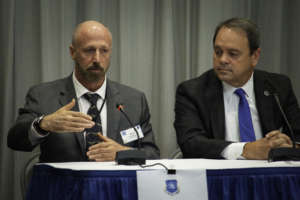
Air Force Space Command has new strategy to harness data
Air Force Space Command is trying to bring its data systems and sets together to benefit its operations.
The organization in charge of the Air Force’s space operations recently set up a roadmap for how it will use the immense amounts of data it collects to change the way it fights wars and conducts day-to-day tasks.
“The purpose of the strategy is to take a challenge and a problem and turn it into a strategic advantage. The ones who solve this first and best are the ones who will win future battles,” Mark Brady, Air Force Space Command chief data officer told Federal News Network. “Our particular strategy is what we call next generation because the previous state-of-the-art won’t be adequate.”

Brady holds the distinction of being the first chief data officer hired by a major Air Force command. His first task was to design an enterprise data strategy that will integrate the information the command takes in into something that can optimize how the Air Force looks at space and operates in multiple domains.
“Decisions and actions are all based on analyses of data and the better that data is the more effective are our actions,” said Gen. Jay Raymond, leader of Air Force Space Command.
The ultimate goal of taking in the large petabytes of information and analyzing them is to eliminate the need for some manual processes and advance artificial intelligence and machine learning.
The strategy will also support interactions between machines. For example, your refrigerator could tell your phone you are out of milk and remind you next time you walk into a grocery store.
“The next generation data strategy starts out with a simple idea, which is understanding the activity of data users,” Brady said.
Analysts and programmers first need to discover data and parse out the important data from the minutiae of information collected. From there, they need to understand what the variables in the dataset tell them. They then access it and combine it with other data.
“Data is only interesting in the context of other data,” Brady said. “That’s where you find your insights. The activities associated with command and control are going to be what make our organization unique.”
Air Force Space Command is creating new data systems specifically for that. Right now, systems are stove-piped and cut off from each other restricting them from working together. A lot of bridges need to be built between those systems and standards need to be put in place so they can work together.
Related Stories

White House hints at Federal Data Strategy, OPEN Govt Data Act, in open-government strategy
From there, Air Force Space Command will eventually create a “super system” comprised of all the systems in the command.
“In that super system you are going to find the variables that drive your mission,” Brady said.
Watching that super system allows data managers to see where information is being transmitted and lets them send it exactly where it needs to go to be processed and analyzed for best use.
The command can also tap into the Unified Data Library, which was created in partnership with the Air Force Research Laboratory and the Space and Missile Systems Center. The library is a cloud-based environment where data can be discovered and understood by the way it’s documented and shared.
“This allows us to support the data users in a way they haven’t been supported before,” Brady said.
To create the strategy, Brady set a team out to visit 82 units at 19 sites to see what they needed from their information.
“That current-state assessment revealed a lot about what is happening in space operations and what operators need,” said Brady. “It identified our strengths, but more importantly it identified areas where we needed to improve.”
Copyright © 2025 Federal News Network. All rights reserved. This website is not intended for users located within the European Economic Area.
Scott Maucione is a defense reporter for Federal News Network and reports on human capital, workforce and the Defense Department at-large.
Follow @smaucioneWFED




